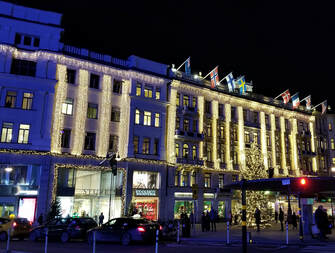 by Marcia Simon, CTA, APR The most popular time to visit Stockholm, Sweden’s capital and most populous city, is summer, with warm days, bustling outdoor cafes and extended hours of daylight to explore the city’s archipelago and canals by foot or by sea. After all, Stockholm is built on 14 beautiful islands connected by 57 bridges. But, as fate would have it, I had family business that called me over in mid-January. I didn’t mind; airfares and hotel rates are lower in winter, and having been to Stockholm about 30 times in my life, I was happy to approach this trip as a journey into winter life in the city. This time I opted not to stay in the tourist area of Gamla Stan (“Old Town” with cobblestone walking streets and preserved medieval architecture), near Djurgården (the island in the southern part of Östermalm that’s home to the famous Vasa Viking ship museum, Skansen outdoor living museum of traditional life, Gröna Lund amusement park and the Abba Museum), hip Södermalm with its artsy vibe and eclectic eateries, or near the ferry terminals that take passengers to the archipelago and numerous water tours of the city. Instead, we stayed in Norrmalm, a 20-minute walk north of the city’s Central Train station, passing by Sorgel Torg, the heart of this busy shopping and working district. Norrmalm is also a cultural hub, with ballet and opera at the Royal Swedish Opera, as well as art exhibits and modern dance at Kulturhuset Stadsteatern. Drottninggatan is a vehicle-prohibited shopping street filled with outdoor cafes and fun places to get a sense of current Swedish design and fashion. It begins close to the Royal Palace where you’ll see shops selling all the expected souvenirs, from t-shirts and Viking horn hats to Swedish crystal and H&M department store bargains. The farther north you walk, the more this becomes part of the local community. We also walked around Vasastan, a neighborhood near Stockholm’s prestigious KTH (Royal Institute of Technology), which was part of my reason for visiting over the winter. In winter, in Norrmalm, you feel less like a tourist and more immersed in daily culture of Swedish life. Here are my observations, some pertinent year-round and some most noticeable in winter:
If it had been summer, and the days were long and warm we’d be more apt to see families and lots of children out on the streets. With school in session and the setting sun closing in on daylight by mid-afternoon, it was a different vibe to see commuters – well-dressed men with their stylish hair and manbags, women bicycling in leggings and skirts, and shiny white lights in every direction. Most people would enjoy Stockholm more in spring, summer or fall. However, stretching a necessary family trip with a quick immersion dump into Stockholm’s winter culture gave us a fun new insight into the winter scene in one of Scandinavia’s most beloved cities. Marcia Simon, APR, CTA is principal of friendlygrouptravel.com and MSE Public Relations. She’s also a writer with special interest in travel, health and wellness. Connect at [email protected], facebook.com/friendlygrouptravel @marciasimon on Twitter or friendlygrouptravel on Instagram. Share
0 Comments
Your comment will be posted after it is approved.
Leave a Reply. |
AuthorMarcia Simon, CTA, APR, has been exploring new places since she was 17 years old and traveled around Europe on a Eurailpass with her best friend. Decades later, she still considers travel the best investment of time and money she's ever made for herself and her family. Categories
All
|
|
SIGN UP NOW FOR OUR NEWSLETTER WITH TRAVEL TIPS, IDEAS AND SPECIAL OFFERS
|

 RSS Feed
RSS Feed





